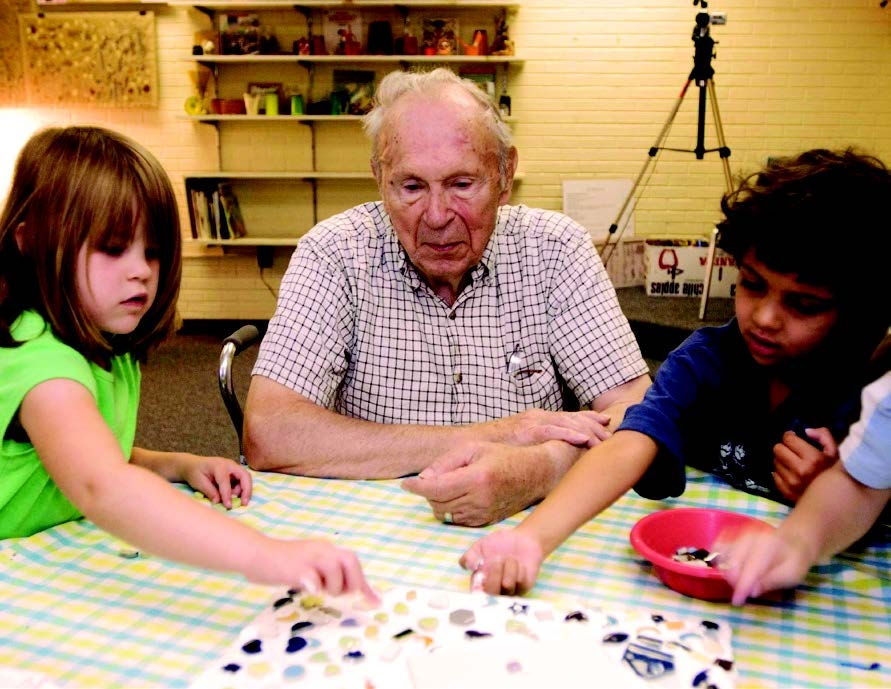Best Practices in Intergenerational Programming: Practice 1
ID
FCS-34P (FCS-154P)
EXPERT REVIEWED

Staff members of the adult and child programs collaborate to plan activities.
Practice1 • Collaboration
Intergenerational programs are most effective when staff members of the adult and child programs collaborate to plan activities. Practically speaking, collaborating takes a concerted effort. Merely setting aside time to discuss plans is a hurdle. Children and adults of different ages have different interests, strengths, and needs. Staff members can review the developmental strengths and needs of children and adults in the program to inform activities for the two age groups. Staff members benefit from their partner’s expertise, which makes planning easier. Participants will benefit from plans that best match their interests and abilities.
Benefits of Collaboration
- Sharing of expertise and knowledge amon g sta.
- Creation of activities reflecting the interest s of both generations.
- Clarification of sta member responsibilities within intergenerational activities.
- Sharing a pool of resources and ideas.
- Development of a team process that saves time and advances the goals of intergenerational programming.
Application of the Practice
Involve families in the collaboration once or twice a year to elicit their ideas. Family mem- bers love to talk about their child or adult family member. They can oer ideas about the child’s interests at home or the adult’s past skills and interests that can lead to enriched program activities.

Use of Photography
Some programs find that taking photos of the participants, then sitting together to review the photos and discuss what occurred, helps sta from both programs reflect on the activity — what worked, what didn’t work, and what they might change if a similar activity were planned in the future.
Program Ideas
- Start by setting aside 30 minutes a week for staff members to plan together.
- Rotate leadership in the planning team.
- Brainstorm and record ALL ideas on an easel pad.
- Consider the participants as well as the setting. Does the environment need to be adjusted in any way?
- Revisit the easel pad each week and start a notebook (on paper or online) to capture great ideas that come to people outside of scheduled planning time.
- Compile a calendar of activities to try.
- Take turns documenting the activity in each session to use for later reflection.
- Use reflection time to identify common elements of successful activities and repeat those characteristics.
- Praise each other for great ideas and celebrate successes together.

Best Practices for Intergenerational Programming
- Staff members of the adult and child programs collaborate to plan activities.
- Participants are involved in decision-making about the activity and during activities.
- Participation is voluntary.
- Participants are prepared ahead of time and reflect on the activity afterward.
- Activities reflect interests, backgrounds, and social histories of program participants.
- Activities are age- and role-appropriate.
- Activities support interaction among intergenerational participants.
- Facilitators skillfully stage the environment to promote interaction.
- Facilitators consider the social environment and the role of staff members.
- Adaptive equipment is used as appropriate.
- Facilitators document and communicate experiences to build on in future activities.
Reference
Jarrott, S. E. 2011. “Where Have We Been and Where Are We Going? Content Analysis of Evaluation Research of Intergenerational Programs.” Journal of Intergenerational Relationships 9:37-52. doi:10.1080/15350770.2011.544594.
Project TRIP
Transforming Relationships Through Intergenerational Programming
A Children’s, Youth, and Families at Risk project of Virginia Tech.
Shannon Jarrott, Professor, Social Work, The Ohio State University
Karen DeBord, (retired) Extension Specialist, Virginia Tech
Contact: Crystal Tyler-Mackey, Extension Specialist and Leader, Community Viability, cmtyler@vt.edu.
This is one of 11 fact sheets on the emerging best practices associated with intergenerational programs.
Intergenerational programs are those that connect younger and older generations to foster positive experiences. Research continues to grow, noting that when successfully delivered, intergenerational programs result in positive health effects, child learning, and appropriate socialization for both young and old (Jarrott 2011). For more information on IG practice, visit https://u.osu.edu/bridge2health/.
Virginia Cooperative Extension materials are available for public use, reprint, or citation without further permission, provided the use includes credit to the author and to Virginia Cooperative Extension, Virginia Tech, and Virginia State University.
Virginia Cooperative Extension is a partnership of Virginia Tech, Virginia State University, the U.S. Department of Agriculture (USDA), and local governments, and is an equal opportunity employer. For the full non-discrimination statement, please visit ext.vt.edu/accessibility.
Publication Date
October 24, 2025



